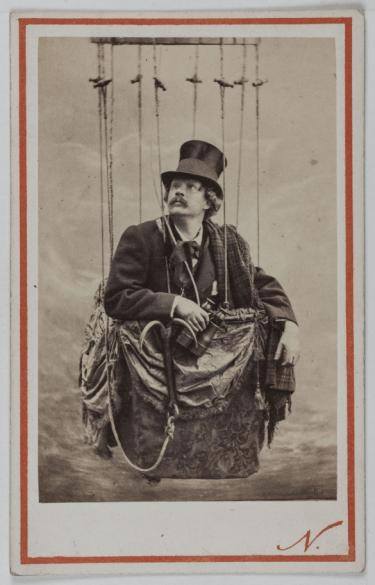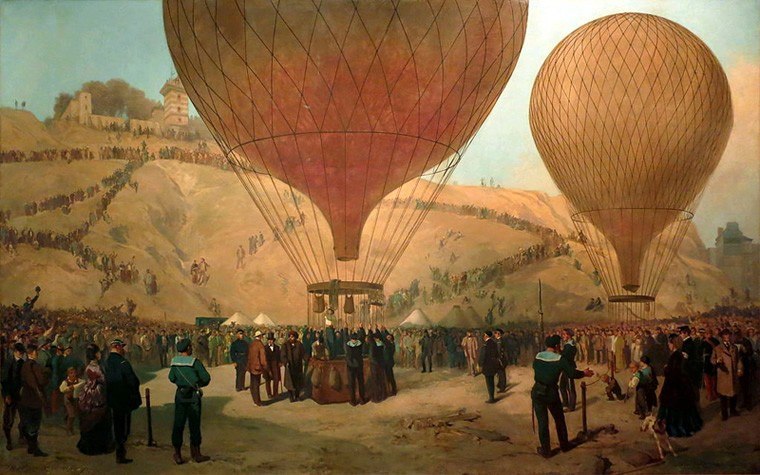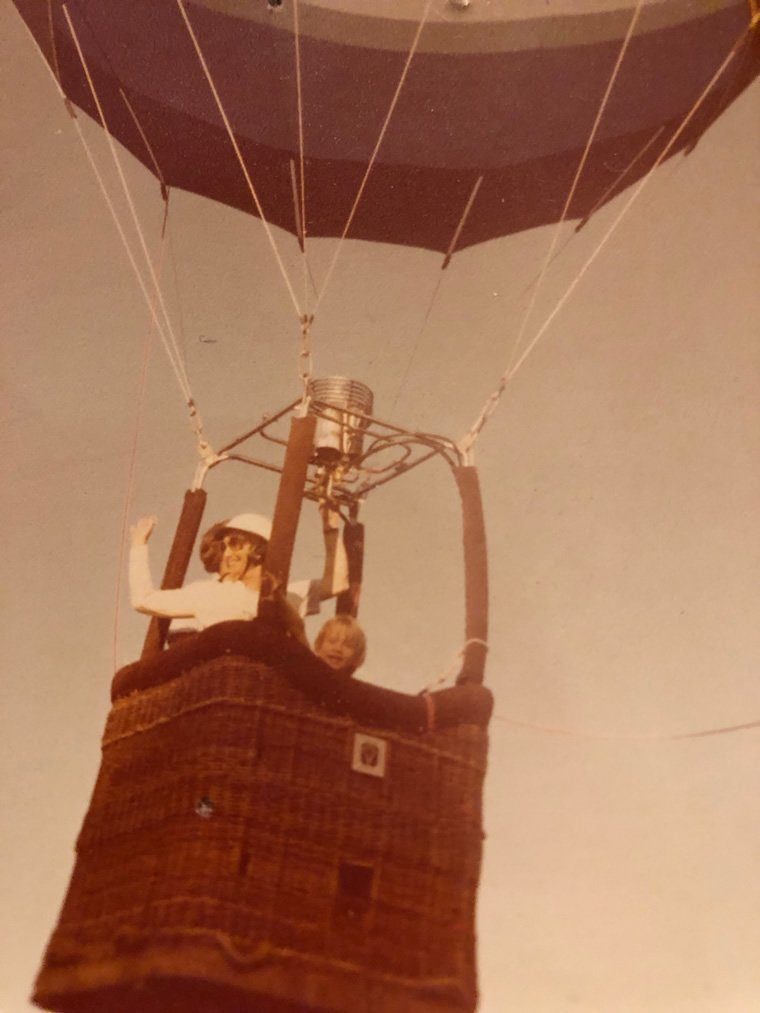Balloon history
Discover our balloon flights over the castles of the Loire.
The man had thought of leaving the ground imitating the bird. In this, he had gone the wrong way. He may have stuck his feathers and beaten his arms very hard, but he did not fly. He had to find a way- like the wheel that allowed him to go faster on earth, of which there was no visible model in nature. It needed a real invention, and this one was the ball. (Icarus's dream).
18th century: the first trials
Joseph Montgolfier, born in 1740, had a real passion for the new machines very fashionable at the time. Together with his younger brother, Etienne, they had often dreamed of human flight. They had even imagined capturing the clouds in a kind of envelope and hanging a basket. But how do we realize this idea? This is the beginning of an adventure, that of the hot air balloon!
It all starts the day Joseph, to dry his shirt, makes it swell by holding it by the collar over the fire in his fireplace, he immediately thinks that he has just made a discovery simply great! He shares it with Etienne and they both begin to imagine the shape of their future invention...

After a few "in-room" tests, they make a one cubic meter silk globe that they heat over a fire. This globe takes off by about thirty meters. It is November 1782, a date that some consider to be the birth of the aerostation.
On December 14, 1782, a 3 cubic meter globe heated with wet straw mixed with wool and paper rose above the Vidalon factory in Annonay. On April 25, 1783, a globe of 800 m3 rose to 400 meters above sea level. Until then, the brothers had worked secretly in their garden, but as the altitude of the flights increased, they feared that their neighbours would discover their experiences and that they would be robbed of the idea: they decided to organize a public flight of their balloon in the main square of Annonay on Wednesday, June 4, 1783.
For this event, they build a 900 m3 balloon made of cotton cloth sewn on sheets of paper cut into spindles assembled by buttonholes. The envelope is held vertically by masts, and hangs a pod filled with straw and wool. When sufficient heat is generated to lift the ball, they cut the ropes and the ball flies away, going up to about 1000 meters during a ten-minute ascent.
When the balloon cooled, about ten minutes later, it landed in a field and began to burn because of the residual fire in the pod. The peasants who work in this field are frightened by this strange contraption from the sky and do nothing to put out the fire. The prototype is completely destroyed.
Fortunately, witnesses to the theft certify its authenticity. A report is drawn up and the Montgolfier brothers write to the Academy of Sciences in Paris to be officially declared as the first to have built a "flying" object: the aerostation was born!

The Academy of Sciences invites them to Paris to give a demonstration. Etienne went there in August 1783 and met several physicists interested in his invention, in particular Pilâtre de Rozier, who would become the first man to fly on what was not yet called a "hot air balloon".

At the same time the physicist Jacques Alexandre Charles built a balloon inflated with hydrogen. A renowned physicist, he believes that the Montgolfier brothers used hydrogen for the swelling of their aerostat during their demonstration on 4 June 1783. He also wants to raise a balloon in the air to perform physics experiments and asks the Robert brothers to make him a balloon 4 meters in diameter. "The Globe" rises on August 27, 1783 from the Champ de Mars and lands at Gonesse north of Le Bourget. This aerostat would later be called a "cart."

After several experiments of captive flights in the gardens of the papermaker Réveillon in Paris, Etienne decides to take another step, that is to say to undertake a human flight. Pilâtre de Rozier proposes to be the passenger, but the effects of such altitude variations on a living organism are not known. They therefore chose to take a duck, a rooster and a sheep for this first manned flight which took place on September 19, 1783 in Versailles, under the eyes of the King of France himself. The animals are recovered unharmed in Vaucresson, 3 km away after a flight of 3 to 8 minutes; the sheep is even grazing quietly. As for the rooster, if he returns with a skinned wing, he owes it, it is said, to a sheep's abruptness... The proof is therefore made that living beings, besides birds of course, are able to fly safely!

On Wednesday, October 15, 1783, in the gardens of rue de Montreuil, Pilâtre de Rozier carried out the swelling of the "hot air balloon" and ascending, in the circular gallery attached to the balloon, was raised captive to the end of the ropes, which were about 25 meters long. On Friday the 17th, the same experience is repeated; a crowd made up of the most brilliant society in Paris invades the gardens. This time the ball rises to a height of 108 meters.
The only obstacle to a human flight is Louis XVI, who, feeling responsible for the lives of his subjects, decided to forbid these experiences. Through negotiations, he eventually gave permission, but refused to attend. The Montgolfier brothers do not steal themselves because they promised their father that they would never fly in their balloon. The latter is not convinced of the safety of their invention! Pilâtre de Rozier is therefore chosen for the flight. It is accompanied by the Marquis of Arlempdes, to balance the gondola. The basket is divided into three parts: the two side parts containing the passengers and the burner occupying the middle. Both passengers can fuel the fire with straw to control the altitude of the balloon.
On November 21, 1783, Pilâtre de Rozier and the Marquis d'Arlempdes, aboard a 2200 m3 aerostat designed by Etienne Montgolfier, rose from the Château de la Muette in Paris. Pilâtre has an innate sense to maneuver the ball. He feels very accurately when it must be heated or cooled while the Marquis d'Arlempdes is content to admire Paris from the sky! They landed at the Butte aux Cailles after a 25-metre flight reaching 1000 m altitude. Throughout the flight, they fed the furnace of the aerostat - a brazier with a paper envelope held by chains - with damp straw, old rags and rotting meat! The Montgolfier brothers had made the first humans fly...
On December 1, 1783, Professor Charles and Robert flew from the Tuileries to Paris in front of 400,000 people in an aerostat of their manufacture: a "hydrogen" balloon. They made a two-hour flight to Nesles-la-Vallée. Charles, after landing, drops off his companion and makes an ascent to three thousand meters! He never rode a balloon again afterwards... This balloon is already a perfect model: varnished envelope, net, wicker pod, swelling appendage, valve, lean and anchor. The gondola even contains a barometer and weather instruments.
In 1784, a woman, Mrs. Tible, flew for the first time. The ascents follow one another in Lyon, Dijon, Marseille, Strasbourg and throughout Europe. In Lyon, Joseph Montgolfier made the first "commercial" flight, taking seven people with him.

Many scientific tests and experiments were carried out in the following years to improve the performance of the hot air balloon as aerostat pilots set out to realize a new dream: to cross the Channel. Pilâtre builds a balloon for this purpose which, in addition to the hot air, contains a small balloon inflated with hydrogen. Despite the advice of Montgolfier, who found this too dangerous, he left France in January 1785. After a few minutes of flight, the flame of the burner comes licking the small hydrogen balloon and the envelope catches fire immediately. The balloon dives and Pilâtre, after being the first man to fly, becomes the first victim of the first air disaster...
When the hot air balloon of Pilâtre de Rozier and the Marquis d'Arlempdes flew over Paris in November 1783, the young André-Jacques Garnerin was among the tens of thousands of Parisians who witnessed this first human flight. The passion for the air will never leave him. Together with his teacher, the physicist Jacques Charles, inventor of the hydrogen aerostat, the young man made several balloon ascents. In Paris, in late 1796 and early 1797, Garnerin in turn built a hydrogen aerostat and made a series of captive ascents and then two free flights. During the second flight, he throws his dog equipped with a parachute in half sphere, which returns to the mainland without damage.
On October 22, 1797, Garnerin invited the All-Paris to witness the first human parachute jump. At 5:29 p.m., at 200 toises (400 meters), he takes his place in a wicker pod hanging under a parachute in half sphere and cuts the rope connecting the parachute to his hydrogen balloon. The spectators, panicked by the oscillations of his machine during the descent fear the worst. The result: a simple sprain at the finish.
Jeanne Labrosse, his pupil-turned-wife, was the first woman to parachute on October 12, 1799. His niece, Elisa, began a long career as a paratrooper in 1815, marked by 39 jumps. During the four years following his feat, Garnerin completed numerous ascents in aerostat, punctuated by frequent parachute jumps in front of paying spectators. He died on August 23, 1823, struck in the head by a large beam while preparing a flight platform.
19th century: the crazy expansion of hot air balloons
The 19th century saw the development of scientific ascents. The goal is to climb as high as possible in order to take air samples for analysis. In June 1802, Humboldt and Bompland climbed. They make numerous observations on temperature and barometric pressure.
Balloons are also quickly used for parties. A balloon was thrown on the day of Napoleon's coronation first before falling the next day near Rome.
In 1836, the English aeronaut Green made the first long crossing (800 km between England and the Duchy of Nassau). Scientific ascents continue at ever higher altitudes.

In 1858, Nadar, a journalist, cartoonist, photographer and painter, took the first aerial photograph from a captive balloon. He then built "The Giant", a balloon of 6000 m3. The first flight took place at the Champ-de-Mars on October 9, 1863 and ended near Meaux. On October 18, "The Giant" leaves Paris with nine passengers. It travels 600 km in 16 hours and lands in Hanover but undergoes a 16 km dragging. "The Giant" is still rising in Brussels, Lyon, Amsterdam but the revenues are far from covering expenses.

It was at the 1867 Exhibition that Giffard installed his first large 5,000 m3 steam captive balloon. He was a great success and the Empress herself wanted to climb there. These public captive balloons will become for forty years the classic attraction of exhibitions and will allow tens of thousands of people to perform their "baptism of the air." In 1868 and 1869 Giffard successively installed two captive balloons of 10,500 and 12,000 m3 in London.
During the siege of Paris in 1870, Nadar offered his services and equipment to observe the movements of the enemy. He's organising the first ball start. Free balloons are then the only way to maintain communications with the province. Nadar, after using the balloons as a captive to observe enemy movements, organized the first start, st. Peter's Square in Montmartre. From September 23, 1870 to January 28, 1871, 66 balloons left Paris. They carry 168 people, 400 pigeons and 11 tons of mail (2,500,000 letters). The most illustrious passenger of the balloons was the Minister of the Interior Léon Gambetta who departed aboard the "Armand Barbès" on October 7, 1870.

In 1878, the highlight of the Exhibition was the colossal captive that Giffard placed in the court of the Tuileries: this balloon holds for a long time all the records of dimensions. It contains 25,000 m3 of pure hydrogen, has a diameter of 36 meters and a height of 55 meters! The gondola, 6 meters in diameter, can remove 50 travelers to 600 meters each ascent. From July 10 to November 4, 1878, the large balloon took 35,000 passengers without any notable incidents.
The captive balloon became very popular and all the newspapers of the time marveled at the spectacle: "The big ball! Who doesn't know him? From all the districts of Paris you can see it, in the row of a street, above a roof, from the Bastille to the Arc de Triomphe, everywhere appears the colossus. This is the familiar phenomenon: the old scientist follows him with his eye, mothers show it to their children, husbands to their wives (...). A colossus is always popular. (The Hall of Fame of Industry of September 30, 1878). Still exploited in 1879, it is opened to the ground by a hurricane.
Following Henri Giffard's incredible feat, captive balloons swarm around the world. A pilot of Giffard, Louis Godard was arguably one of the greatest manufacturers of the time. From 1884 to 1899, Louis Godard used captive balloons in many cities: Nice, Turin, Barcelona, Buenos Aires, Rome, Copenhagen, Chicago, Mexico City, Budapest, Leipzig, Cairo, Geneva...
The end of the 19th century was marked by the sending of sounding balloons at very high altitudes, always with the aim of taking air samples. This idea dates from the end of the 18th century but can only be realized from 1892.
The 1900 World's Fair saw the organization of numerous balloon competitions. Several exercises are carried out; it is first to cross the greatest possible distance in a minimum of time, then to go as high as possible and finally to land as best as possible!

20th century: decline... and renewal.
The reign of "lighter than air" (inflated with hydrogen, hot air and soon helium) then seems to stop. This type of air travel does not withstand the newcomers: the "heavier than the air", in other words the planes...
From 1900 to 1930, some hot air balloons survived. The use of a hot air balloon is reported in Switzerland, during an outdoor performance of Cirque Knie, as a support for a trapeze artist! And scientific research continues anyway. Louis Godart developed an oil burner as well as Cornier and Japy. But in the 1930s, accidents such as the hindenburg zeppelin explosion seemed to give a fatal blow to the operation of airships.
On May 27, 1931, Auguste Piccard became the first man to enter the stratosphere aboard a pressurized spherical capsule of his invention, carried away by a gas balloon. In 1937, Professor Piccard and Hay Cosyns tested a propane burner. The idea was reborn and developed thanks to the appearance of new materials. With Raven-Industrie, Ed Yost and Don Piccard invented the modern hot air balloon, the one that, a few years later, will arrive in Europe in its current form.


With the war, the troops of observers in balloons (captives, for artillery) are dissolved and all balloons stored in a hangar. In 1945, they are in poor condition: the rubberized canvas has poorly supported storage. Almost new, the "Forsanose" is in better condition. It was decided to turn it into a hot air balloon with an oil burner.
On September 28, 1946, Ernst Huber and Hans Fehr made the first flight aboard a modern hot air balloon. In 1951, J.A. Contes built a hot air balloon in Akron in the USA. In 1959, NASA conducted tests for the recovery of pilots shot down in Vietnam, using a nylon casing and a burner.
With the advent of nylon and propane burner, British balloon manufacturer Don Cameron reinvented the "rozière." Helium replaces hydrogen, propane burners, braziers and 20th century materials do the rest: the system becomes safe, efficient and allows its designer to attempt the crossing of the Atlantic in 1978. Then, in 1992, it was up to Bertrand Piccard and Wim Verstraeten to win the race across the same Atlantic. It is only natural that they adopted kerosene burners and used the same technique and the same manufacturer for their last successful attempt to circumnak around the world with the Breitling-Orbiter 3, a rozière ... and not a hot air balloon!

Source: momes.net








